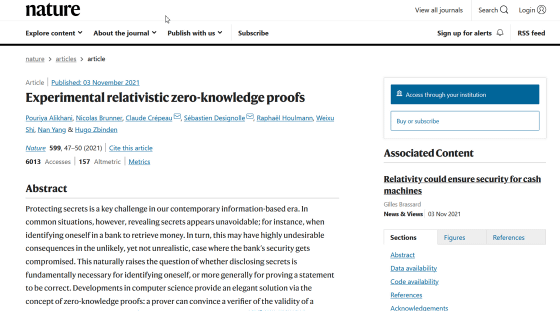Researchers claim that 'non-hackable ATMs' can be created based on Einstein's special theory of relativity

ATMs and crypto asset exchanges use ID numbers and PINs to verify the identity of users in order to protect their valuable assets. However, if an ATM is equipped with skimming equipment or a company's server is hacked on a large scale, personal information will be leaked and security will be compromised. Therefore, research teams in Canada and Switzerland announced that they have devised 'a method of identity verification that cannot be hacked because personal information is not exchanged' based on
Experimental relativistic zero-knowledge proofs | Nature
https://www.nature.com/articles/s41586-021-03998-y

Securing data transfers with relativity | EurekAlert!
https://www.eurekalert.org/news-releases/933317
Einstein's theory of special relativity could help create unhackable ATMs --CNET
https://www.cnet.com/news/einsteins-theory-of-special-relativity-could-help-create-unhackable-atms/
The research team thought that 'verifying the identity without revealing personal information' is effective in countering security breaches in identity verification at ATMs and the like. Therefore, I focused on a method of exchange called 'zero-knowledge proof.'
Zero-knowledge proof is a method of exchange that can be proved without giving any information other than 'the proposition is true' in order to convey that the mathematical proposition that one has is true. For example, suppose that there is a 'verifier' named B who can identify a color to a 'verifier' named A who cannot identify a color, and B wants to tell that 'I can identify a color'.
In this case, A holds the blue and red cards in both hands and shows the card to B to see which is blue and which is red. A then hides the cards behind him so that they don't look like B, swaps or pretends to swap, and shows B the two cards again. Then, if you ask 'Did you replace the card earlier?', B, whose color can be identified, can answer with a 100% probability whether the card has been replaced. This one or two times may be the correct answer by chance, but by repeating this question a huge number of times, it can be proved that even if A cannot identify the color, B can identify the color.
Zero-knowledge proof has been used in fields related to crypto assets since it was first formulated in the 1980s. However, there are problems that some functions cannot be decoded due to restrictions such as being based on mathematical assumptions, and that security is violated if the underlying mathematical assumptions are disproved. And that. Therefore, the research team claims to have strengthened the zero-knowledge proof by being based on Einstein's special theory of relativity.

The research team used a mathematical
The newly announced identity verification method is to give the certifier a huge map that is painted in three colors in advance, and the verifier asks the certifier for the color of the node at the time of identity verification. The three-color problem is too complicated to solve, but the prover has the correct map in advance, so he can return the correct answer no matter which node is asked. Also, by regularly changing the colors like 'green → blue' 'blue → red' 'red → green', it can be difficult for hackers to guess the map from the certifier's answer. In the real world, a user (certifier) who wants to withdraw cash can perform this process, such as by inserting the device into an ATM (verifier) device.
However, the research team points out that this process leaves a small chance for hackers to back-calculate the map from the answer, which is not perfect. This is the same as multiplying two large prime numbers to produce a very large number, which is very difficult to decompose, but not absolutely impossible. Therefore, based on Einstein's special theory of relativity, 'information cannot move faster than light,' we proposed a method to further strengthen the zero-knowledge proof.
The method devised by the research team is 'Make two pairs of verifier and prover, the verifier randomly selects two adjacent nodes from the map, and the two provers have different node colors. At the same time. ' In a properly painted map, the colors of adjacent nodes will be different, so the colors that the certifier will answer will always be different. If there is a certain distance between two verifiers, it becomes impossible to cheat to transfer information between verifiers before answering, based on the principle of special relativity that 'information cannot move faster than light'. , It is a mechanism that the validity of the answer is guaranteed.
'The idea behind this technique is that the idea behind this technique is to interrogate the two suspects in different rooms and prevent them from communicating with each other,' said Sébastien Designolle, a physicist and co-author of the paper at the University of Geneva. It's the same. If they're telling the same thing, it's a good hint that they're telling the truth. ' In the actual verification, by asking 3 million questions between the verifier and the prover in a short time of less than 3 seconds, the possibility that the answers of the two provers accidentally match is also eliminated.

In fact, the research team seems to have experimented with this concept with a pair of verifier and prover separated by 60 m or more, and it is possible to put it to practical use without using complicated and expensive technology. The research team also believes that the distance between verifiers can be reduced to 1m in the near future.
Related Posts:
in Science, Posted by log1h_ik







